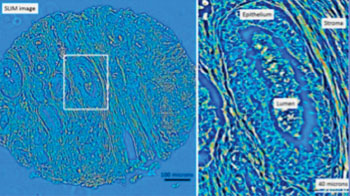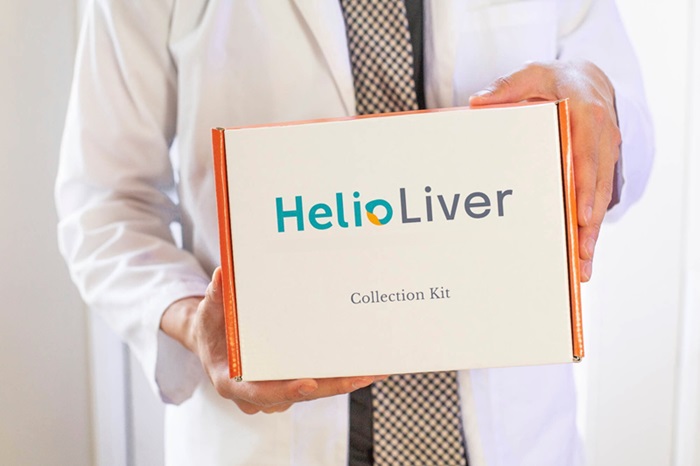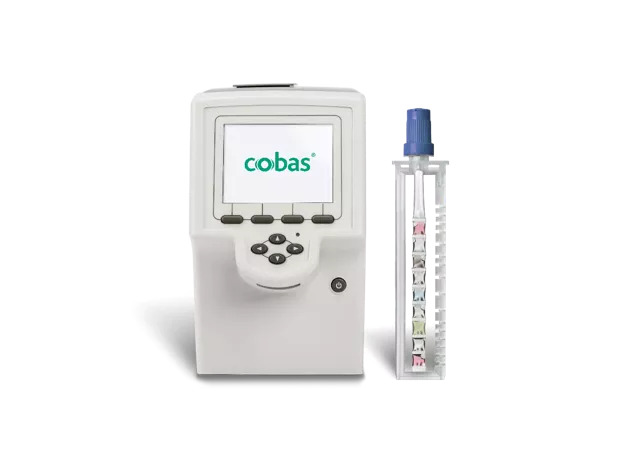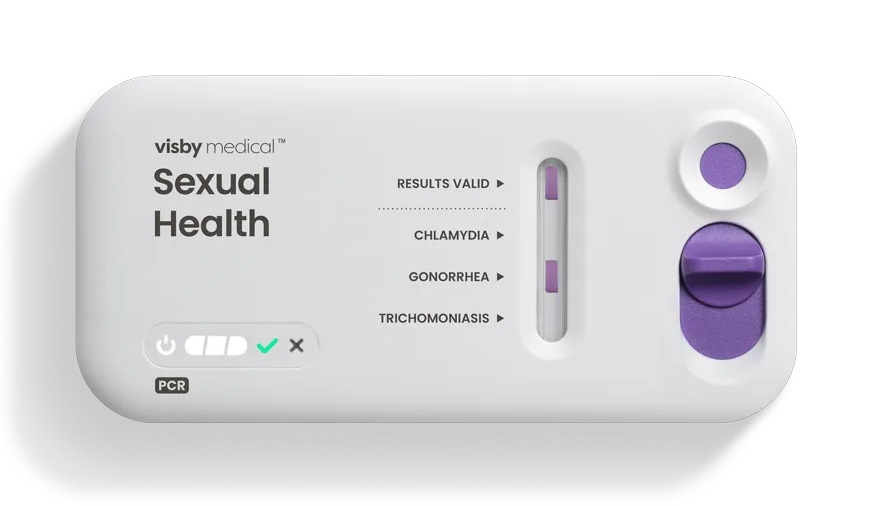Pathologists Use Spatial Light Interference Microscopy to Predict Risk of Prostate Cancer Recurrence Prior to Biopsy or Surgery
|
By LabMedica International staff writers Posted on 24 May 2015 |

Image: Left: Quantitative phase image of an unstained prostatectomy sample from a patient who had a biochemical recurrence of prostate cancer. Right: A zoomed-in region from the quantitative phase image showing a cancerous gland with debris in the lumen. The stroma, or supportive tissue environment, shows discontinuities in the fiber length and disorganization in the orientation of the fibers (Photo courtesy of the University of Illinois).
A novel microscopy method that combines phase contrast microscopy with holography enables prediction of the likelihood of prostate cancer recurrence prior to biopsy or surgery.
The method is called spatial light interference microscopy or SLIM. SLIM uses a commercial phase contrast microscope and white light illumination, resulting in nanometer scale sensitivity to optical path-length shifts. In essence, SLIM combines phase contrast microscopy with holography.
Investigators at the University of Illinois (Urbana, USA) have introduced a new instrument for SLIM imaging. Their real-time fast SLIM technique could image at a maximum rate of 50 frames per second and provided real-time quantitative phase images at 12.5 frames per second. They were able to achieve this fast rate by combining rapid LCPM (linear pulse-code modulation) and a fast sCMOS camera. In addition, they developed the software to perform phase reconstruction and display the quantitative phase images in real-time.
In the current study, the investigators used the SLIM technique to examine 181 tissue samples obtained from the [US] National Cancer Institute-sponsored Cooperative Prostate Tissue Resource (CPCTR), The specimens were taken from individuals who had a prostatectomy, approximately half who had no recurrence and half who did.
The instrument was programmed to scan microscope slides containing 320–360 individual cores. The resulting SLIM image contained rich information about tissue morphology, with the glandular epithelium and stroma structures clearly resolved. This allowed the investigators to interrogate scattering changes specific to prostate stroma.
Results suggested that SLIM showed promise in assisting pathologists to improve prediction of prostate cancer recurrence. The data revealed that a lower value of anisotropy corresponded to a higher risk for recurrence, meaning that the stroma adjoining the glands of recurrent patients was more fractionated than in non-recurrent patients. Anisotropy is the property of being directionally dependent, as opposed to isotropy, which implies identical properties in all directions. It can be defined as a difference, when measured along different axes, in a material's physical or mechanical properties.
"For every 20 surgery procedures to take out the prostate, it is estimated that only one life is saved," said senior author Dr. Gabriel Popescu, associate professor of electrical and computer engineering at the University of Illinois. "For the other 19 people, they would be better left alone, because with removing the prostate, the quality of life goes down dramatically. So if you had a tool that could tell which patient will actually be more likely to have a bad outcome, then you could more aggressively treat that case."
"What SLIM is very good at is to make invisible objects visible with nanoscale sensitivity," said Dr. Popescu. "So we pick these structural details without the need for staining, which can introduce new variables into the specimen. Our dream is for everyone to have SLIM capabilities in their labs. One can imagine that a SLIM-based tissue imager will scan biopsies in a clinic and, paired with software that is intelligent enough to look for these specific markers, will provide the pathologist with valuable new information. This additional information will translate into more accurate diagnosis and prognosis."
The paper describing the use of SLIM to predict prostate cancer recurrence was published in the May 15, 2015, online edition of the journal Scientific Reports.
Related Links:
University of Illinois
The method is called spatial light interference microscopy or SLIM. SLIM uses a commercial phase contrast microscope and white light illumination, resulting in nanometer scale sensitivity to optical path-length shifts. In essence, SLIM combines phase contrast microscopy with holography.
Investigators at the University of Illinois (Urbana, USA) have introduced a new instrument for SLIM imaging. Their real-time fast SLIM technique could image at a maximum rate of 50 frames per second and provided real-time quantitative phase images at 12.5 frames per second. They were able to achieve this fast rate by combining rapid LCPM (linear pulse-code modulation) and a fast sCMOS camera. In addition, they developed the software to perform phase reconstruction and display the quantitative phase images in real-time.
In the current study, the investigators used the SLIM technique to examine 181 tissue samples obtained from the [US] National Cancer Institute-sponsored Cooperative Prostate Tissue Resource (CPCTR), The specimens were taken from individuals who had a prostatectomy, approximately half who had no recurrence and half who did.
The instrument was programmed to scan microscope slides containing 320–360 individual cores. The resulting SLIM image contained rich information about tissue morphology, with the glandular epithelium and stroma structures clearly resolved. This allowed the investigators to interrogate scattering changes specific to prostate stroma.
Results suggested that SLIM showed promise in assisting pathologists to improve prediction of prostate cancer recurrence. The data revealed that a lower value of anisotropy corresponded to a higher risk for recurrence, meaning that the stroma adjoining the glands of recurrent patients was more fractionated than in non-recurrent patients. Anisotropy is the property of being directionally dependent, as opposed to isotropy, which implies identical properties in all directions. It can be defined as a difference, when measured along different axes, in a material's physical or mechanical properties.
"For every 20 surgery procedures to take out the prostate, it is estimated that only one life is saved," said senior author Dr. Gabriel Popescu, associate professor of electrical and computer engineering at the University of Illinois. "For the other 19 people, they would be better left alone, because with removing the prostate, the quality of life goes down dramatically. So if you had a tool that could tell which patient will actually be more likely to have a bad outcome, then you could more aggressively treat that case."
"What SLIM is very good at is to make invisible objects visible with nanoscale sensitivity," said Dr. Popescu. "So we pick these structural details without the need for staining, which can introduce new variables into the specimen. Our dream is for everyone to have SLIM capabilities in their labs. One can imagine that a SLIM-based tissue imager will scan biopsies in a clinic and, paired with software that is intelligent enough to look for these specific markers, will provide the pathologist with valuable new information. This additional information will translate into more accurate diagnosis and prognosis."
The paper describing the use of SLIM to predict prostate cancer recurrence was published in the May 15, 2015, online edition of the journal Scientific Reports.
Related Links:
University of Illinois
Latest Pathology News
- New Technique Reveals Earliest Signs of Genetic Mutations
- New WHO Reporting System for Lung Cytopathology to Enhance Diagnostic Accuracy
- Self-Taught AI Tool Diagnoses and Predicts Severity of Common Lung Cancer
- Novel AI-Powered Method for Tissue Analysis Improves Understanding of Disease Pathology
- Noninvasive Technology Detects Rare Cancer Cells in Blood
- AI Tool Detects Tiny Protein Clumps in Microscopy Images in Real-Time
- New Tool Enables Better Classification of Inherited Disease-Causing Variants
- Groundbreaking CRISPR Screen Technology Rapidly Determines Disease Mechanism from Tissues
- New AI Tool Classifies Brain Tumors More Quickly and Accurately
- AI Integrated With Optical Imaging Technology Enables Rapid Intraoperative Diagnosis
- HPV Self-Collection Solution Improves Access to Cervical Cancer Testing
- Hyperspectral Dark-Field Microscopy Enables Rapid and Accurate Identification of Cancerous Tissues
- AI Advancements Enable Leap into 3D Pathology
- New Blood Test Device Modeled on Leeches to Help Diagnose Malaria
- Robotic Blood Drawing Device to Revolutionize Sample Collection for Diagnostic Testing
- Use of DICOM Images for Pathology Diagnostics Marks Significant Step towards Standardization
Channels
Clinical Chemistry
view channel
New ADLM Guidance Provides Expert Recommendations on Clinical Testing For Respiratory Viral Infections
Respiratory tract infections, predominantly caused by viral pathogens, are a common reason for healthcare visits. Accurate and swift diagnosis of these infections is essential for optimal patient management.... Read more
3D Printed Point-Of-Care Mass Spectrometer Outperforms State-Of-The-Art Models
Mass spectrometry is a precise technique for identifying the chemical components of a sample and has significant potential for monitoring chronic illness health states, such as measuring hormone levels... Read more.jpg)
POC Biomedical Test Spins Water Droplet Using Sound Waves for Cancer Detection
Exosomes, tiny cellular bioparticles carrying a specific set of proteins, lipids, and genetic materials, play a crucial role in cell communication and hold promise for non-invasive diagnostics.... Read more
Highly Reliable Cell-Based Assay Enables Accurate Diagnosis of Endocrine Diseases
The conventional methods for measuring free cortisol, the body's stress hormone, from blood or saliva are quite demanding and require sample processing. The most common method, therefore, involves collecting... Read moreMolecular Diagnostics
view channel
Blood-Based Test Outperforms Ultrasound in Early Liver Cancer Detection
Patients with liver cirrhosis and chronic hepatitis B are at a higher risk for developing hepatocellular carcinoma (HCC), the most prevalent type of liver cancer. The American Association for the Study... Read more
Four-In-One Molecular Test Detects and Differentiates Among Most Prevalent Respiratory Viruses in 20 Minutes
The U.S. Centers for Disease Control and Prevention (CDC) has reported that respiratory diseases in the United States reached high levels during the recent autumn and winter seasons, with SARS-CoV-2 leading... Read more.jpeg)
First-Line PSA Testing More Cost-Effective Than First-Line MRI for Prostate Cancer Screening
Current prostate cancer (PCa) screening protocols typically begin with prostate-specific antigen (PSA) testing, which, if elevated, may lead to further assessment using multiparametric magnetic resonance... Read more
Proteomics Platform Identifies Proteins in Blood to Give Cancer Warning 7 Years before Diagnosis
To improve cancer survival rates, it's crucial to understand the disease during its initial stages. Research involving data from thousands of cancer patients has uncovered exciting findings about how blood... Read moreHematology
view channel
Next Generation Instrument Screens for Hemoglobin Disorders in Newborns
Hemoglobinopathies, the most widespread inherited conditions globally, affect about 7% of the population as carriers, with 2.7% of newborns being born with these conditions. The spectrum of clinical manifestations... Read more
First 4-in-1 Nucleic Acid Test for Arbovirus Screening to Reduce Risk of Transfusion-Transmitted Infections
Arboviruses represent an emerging global health threat, exacerbated by climate change and increased international travel that is facilitating their spread across new regions. Chikungunya, dengue, West... Read more
POC Finger-Prick Blood Test Determines Risk of Neutropenic Sepsis in Patients Undergoing Chemotherapy
Neutropenia, a decrease in neutrophils (a type of white blood cell crucial for fighting infections), is a frequent side effect of certain cancer treatments. This condition elevates the risk of infections,... Read more
First Affordable and Rapid Test for Beta Thalassemia Demonstrates 99% Diagnostic Accuracy
Hemoglobin disorders rank as some of the most prevalent monogenic diseases globally. Among various hemoglobin disorders, beta thalassemia, a hereditary blood disorder, affects about 1.5% of the world's... Read moreImmunology
view channel.jpg)
AI Tool Predicts Cancer Patients’ Response to Immunotherapy
Immune checkpoint inhibitors are a form of immunotherapy drug that enables immune cells to target and destroy cancer cells. At present, the Food and Drug Administration has approved two predictive biomarkers... Read more
Molecular Profiling Improves Diagnosis for Children with High Risk Cancers
Cancer remains the leading cause of disease-related death among children in most developed nations, and approximately one-fourth of these patients are diagnosed with aggressive, high-risk, or relapsed... Read moreMicrobiology
view channel
POC STI Test Shortens Time from ED Arrival to Test Results
In a 2024 sexually transmitted infections (STIs) surveillance report by the World Health Organization (WHO), over 2.5 million cases were recorded, alongside a rise in the inappropriate use of antibiotics... Read more
Integrated Solution Ushers New Era of Automated Tuberculosis Testing
Tuberculosis (TB) is responsible for 1.3 million deaths every year, positioning it as one of the top killers globally due to a single infectious agent. In 2022, around 10.6 million people were diagnosed... Read more
Automated Sepsis Test System Enables Rapid Diagnosis for Patients with Severe Bloodstream Infections
Sepsis affects up to 50 million people globally each year, with bacteraemia, formerly known as blood poisoning, being a major cause. In the United States alone, approximately two million individuals are... Read moreEnhanced Rapid Syndromic Molecular Diagnostic Solution Detects Broad Range of Infectious Diseases
GenMark Diagnostics (Carlsbad, CA, USA), a member of the Roche Group (Basel, Switzerland), has rebranded its ePlex® system as the cobas eplex system. This rebranding under the globally renowned cobas name... Read moreTechnology
view channel
Microneedle Patch Detects Skin Cancer Early
Wearable bioelectronics has emerged as a significant innovation in healthcare, especially in the field of biosensing, providing a new method to monitor individual health for both diagnostic and therapeutic purposes.... Read more
New Diagnostic System Achieves PCR Testing Accuracy
While PCR tests are the gold standard of accuracy for virology testing, they come with limitations such as complexity, the need for skilled lab operators, and longer result times. They also require complex... Read moreIndustry
view channel
Roche and Hitachi High-Tech Extend 46-Year Partnership for Breakthroughs in Diagnostic Testing
Roche (Basel, Switzerland) and Hitachi High-Tech (Tokyo, Japan) have renewed their collaboration agreement, committing to a further 10 years of partnership. This extension brings together their long-standing... Read more
Danaher and Johns Hopkins University Collaborate to Improve Neurological Diagnosis
Unlike severe traumatic brain injury (TBI), mild TBI often does not show clear correlations with abnormalities detected through head computed tomography (CT) scans. Consequently, there is a pressing need... Read more
Beckman Coulter and MeMed Expand Host Immune Response Diagnostics Partnership
Beckman Coulter Diagnostics (Brea, CA, USA) and MeMed BV (Haifa, Israel) have expanded their host immune response diagnostics partnership. Beckman Coulter is now an authorized distributor of the MeMed... Read more_1.jpg)












.jpg)


